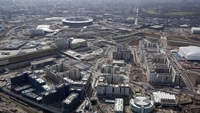London Olympics will drive remote editing

Every Olympics seems to promote the development of some aspect of TV broadcasting or production, such as HD for the Beijing Games in 2008. The 2012 games in London are likely to drive broadcasters toward remote or centralized editing, at least according to Per Lindgren, vice president of business development and founding member of Swedish media transport technology vendor Net Insight.
Video editing requires access to either uncompressed or lightly compressed sources at very high bit rates, and until recently, it had to be done on location for outside broadcast events because of networking costs, even if the capacity was available. But recently, there has been a trend toward centralized editing, such as with Scandinavian telco TeliaSonera using Net Insight’s Nimbra video switching platform to carry uncompressed SD video for live broadcast transmissions of Sweden's premier football league matches since April 2009.
At the London Olympics, most of the transmissions will be in HD. Even so, Lindgren believes there will be a boom in remote editing. In Beijing, there was plenty of space for editing because the Chinese cleared a whole block of housing to make way for a large production facility available to foreign broadcasters.
“But in London, it will be more crowded, and studio prices will be higher,” Lindgren said.
At the same time, there will be lots of optical fiber available to carry the high-bit-rate video required. It will then come down to price, with broadcasters finding it cheaper to distribute the unedited video than to rent space to produce video ready for distribution at lower bit rates.
Discussions are now taking place between broadcasters and fiber providers in London, and one question is whether to transmit the unedited video completely uncompressed or to employ lossless or near-lossless compression techniques to reduce the bit rate by a few times. The point is that unedited video must be transmitted with very low delay to ensure that HD quality is achieved for final distribution. And, when the editing is performed remotely, the time taken for the optical transmission has to be factored into the latency budget. This could easily reach 50ms if the studio was say Japan or the western United States, for example. Additionally, this delay on top of a compression delay could be disastrous. That is why some broadcasters will consider taking uncompressed, unedited video around the world from the London Olympics.
Another possibility is to use the lossless version of the JPEG 2000 compression mechanism, announced by Norwegian encoding vendor T-VIPS at IBC 2010, which reduces the HD stream from the uncompressed 1.5Gb/s to about 500Mb/s without affecting quality; however, this does introduce delay.
Get the TV Tech Newsletter
The professional video industry's #1 source for news, trends and product and tech information. Sign up below.
In general, besides the special case of the London Olympics, broadcasters will consider transporting uncompressed video only when they have access to low-cost “dark” fiber, that is, leasing just the physical fiber itself rather than a complete, managed end-to-end link at a given bit rate. If dark fiber is not available and broadcasters have to go over a public network, or lease overall capacity from a telco, they may not even consider totally lossless JPEG 2000 but go for the near-lossless version or for the new 10-bit profile of MPEG-4, both of which bring down the bit rate around 10-fold to 150Mb/s.
